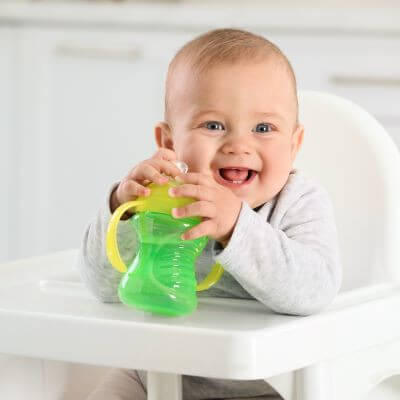The transition from bottles to cups is an important milestone for toddlers. According to the American Academy of Pediatrics, most children can start transitioning away from bottles and breastfeeding between 12 to 24 months. However, most children will have difficulties trying to use a normal cup initially. Training cups, or sippy cups, help children phase out bottles and learn how to sip from a cup.
What type of sippy cup should my child use?
Selecting the right training cup for your child is critical to developing proper oral motor skills. The goal of training cups is supposed to be to teach children to sip rather than suck. No-spill sippy cups are appealing due to their mess-prevention features, but they function essentially the same as baby bottles since they require the child to suck. Unfortunately, the valve that stops spills also makes it impossible for kids to practice sipping. No-spill cups are okay to use on occasion, but they should not be a child’s primary drinking container.
Look for training cups that encourage sipping, such as a training cup with:
- A snap or screw on lid with a sprout (no valve)
- Two handles
- A weighted bottom to keep it up right to avoid spills
Best Beverages to Put in Training Cups
Some drinks are healthier for your child’s smile than others. Fluoridated water is the most tooth-healthy drink option. Fluoride helps children develop strong teeth and prevents tooth decay. About ¾ of community water sources in the United States contain fluoride. If your family’s primary water source is not supplemented with fluoride, let us know at your child’s next appointment. We may recommend a fluoride supplement depending on your child’s needs.
Milk and regular water are also tooth-healthy beverages for toddlers and are great to put in your child’s sippy cup. Toddlers can also drink juice in their sippy cups in moderation but should only do so at mealtimes. The American Academy of Pediatrics guidelines states that juice has no nutritional value for children under 12 months. Fruit juices are high in sugar and can increase children’s risk of tooth decay. Saliva flow is typically higher after a meal, which helps wash away excess sugar from the juice.
Set Your Child up for Successful Sipping!
Learning to use a regular cup is a skill that takes time for children to develop. The best way to fine-tune this skill is to practice! Set your child up for a successful transition away from bottles by having them use a training cup between meals and when you are out and about. Save using regular cups for mealtimes, so you can monitor them and encourage proper techniques. To avoid spills, only put a small amount of liquid in a cup your child can comfortably grip. Paper cups and cups with handles are the most user-friendly option for children to use when first starting out.
Sippy cups are a great tool to help your child learn how to use regular cups! Children should only use sippy cups until around age 2. Using a sippy cup for too long can cause tongue thrust, dental concerns, and speech issues. If your toddler is having trouble phasing out sippy cups, let us know at their next appointment. We can provide guidance and support.







